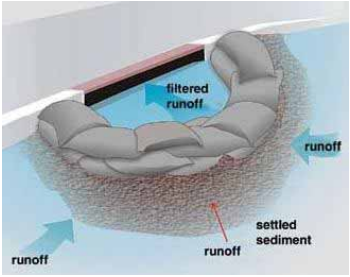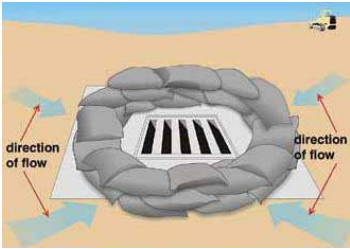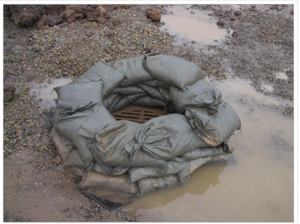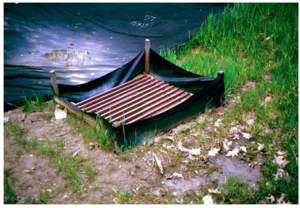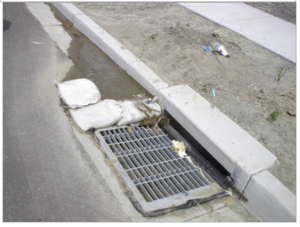
Sediment control practices - Storm drain inlet protection
This page is under development. We anticipate populating it in autumn, 2016.
Contents
Storm Drain Inlet Protection
Definition
Inlet protection includes a wide variety of approaches for trapping sediment through physical filtration and settling processes before it enters a storm drain. There are many options and variations available. Inlet protection is part of a system of erosion prevention and sediment control, and works best when upslope sources of sediment are reduced – primarily by stabilizing bare areas and maintaining perimeter controls.
Purpose and Function
Inlet protection devices intercept, and/or filter sediment before it can be transported from a site into the storm drain system and discharged into a lake, river, stream, wetland, or other waterbody. These devices also keep sediment from filling or clogging storm drain pipes, ditches, and downgradient sediment traps or ponds. Inlet protection may also include placement of a barrier to create a bypass of an inlet transferring flow downstream to a sediment trap, basin, or other inlet discharging to a non-critical area.
Applicability
Inlet protection devices may be applied to any curb inlet, drop inlet, manhole, catch basin, or other entry point to the stormwater drainage system that might receive inflows with high sediment levels. Inlet protection is critical because it often is the last treatment measure before stormwater enters receiving waters.
Site Applicability
Construction sites often drain toward the inlets, pipes, and ditches that comprise the stormwater drainage system. Inlet protection devices can help protect these surface and subsurface systems from high levels of sediment in runoff. Inlet protection in areas with surface drainage ditches are usually only protected by stabilization practices, perimeter controls, and sediment traps. Consider the following when evaluating the use of inlet protection for a site:
- Most inlet protection devices are suitable for a drainage area of one acre or less. Runoff from larger disturbed areas should be routed to more suitable BMPs such as a temporary sediment trap or temporary sediment basin.
- Inlet protection devices may result in ponding of water around the inlet. This may result in a traffic hazard depending on site location.
- Inlet protection should be located in areas where potential ponding will not have adverse impacts.
- Under high flow conditions, sediment removal may be ineffective.
- Inlet protection is intended for low flows having relatively low sediment loading.
- Inlet protection that is not properly installed, maintained, or removed may result in short-circuiting of flow and introduction of sediment into the storm drain system.
- Stabilizing bare soil areas draining to the inlet and maintaining perimeter controls (e.g., silt fence, fiber logs) can help to prevent sediment overloads at inlet locations.
Permit Applicability
Section IV.C.1 of the 2013 MPCA Construction Stormwater General Permit states that the permittee(s) “must employ Sediment control practices as necessary to minimize sediment from entering surface waters, including curb and gutter systems and storm sewer inlets.” In addition, Section IV.C.4 stipulates that “(a)ll storm drain inlets must be protected by appropriate BMPs during construction until all sources with potential for discharging to the inlet have been stabilized. Inlet protection may be removed for a particular inlet if a specific safety concern (street flooding/freezing) has been identified by the Permittee(s) or the jurisdictional authority (e.g., city/county/township/MnDOT engineer). The Permittee(s) must document the need for removal in the SWPPP.”
Where permanent stormwater controls include filtration systems, Section III.D.1.d of the 2013 MPCA Construction Stormwater General Permit specifies that “(t)o prevent clogging of the infiltration or filtration system, the Permittee(s) must use a pretreatment device such as a vegetated filter strip, small sedimentation basin, or water quality inlet (e.g., grit chamber) to settle particulates before the stormwater discharges into the infiltration or filtration system.”
Effectiveness
Properly selected, installed, and maintained inlet protection devices can remove 25-35 percent of total solids and up to 15-25 percent of nutrients from incoming flows (Florida DOT 2010). They work very well in keeping sandy and some silty soils out of storm drains, but have somewhat limited effectiveness with fine clay soils passing through the barrier. Supplementing downgradient inlet protection devices with upgradient soil stabilization and perimeter controls increases in importance as site soils become finer (e.g., clays). Filter fabric can be added to inlet protection devices using coarse stone or aggregate to enhance sediment removal. However, the possibility of increased ponding should be considered. The following table summarizes expected performance for an array of typical water quantity and quality target constituents for storm drain inlet protection BMPs that are properly designed, installed, and maintained.
Expected performance for storm drain inlet protection
Link to this table
| Water Quantity | |
|---|---|
| Flow attenuation | Little or no design benefit |
| Runoff volume reduction | Little or no design benefit |
| Water Quantity | |
| Pollution prevention | |
| Soil erosion | Little or no design benefit |
| Sediment control | Primary design benefit |
| Nutrient loading | Secondary design benefit |
| Pollutant removal | |
| Total suspended solids | Primary design benefit |
| Total phosphorus | Secondary design benefit |
| Heavy metals | Secondary design benefit |
| Floatables | Little or no design benefit |
| Oil and grease | Little or no design benefit |
Planning Considerations
Install inlet protection devices before upslope soil disturbance occurs. In newly developed areas, inlet protection should be placed immediately after the storm sewer inlets are installed. It is critical that the storm sewer inlet not be completely blocked by inlet protection when public safety is a concern. Inlet protection should only be used in locations where sediment can be removed and temporary ponding will not create a public safety hazard or cause property damage. Blocking an inlet can cause streets to flood and sediment to build up. Select inlet protection devices that do not pond water where adjacent areas are open to traffic. Examples of these include low-profile filter berms and filters suspended in the inlet structure. Because inlet protection devices are high-maintenance BMPs, ensure that up-gradient soil stabilization, perimeter protection, and other erosion control practices are in place to minimize the amount of sediment in stormwater flowing to inlets. Note that straw bales are not approved as inlet BMPs.
Design
Performance of all types of inlet protection depends on proper installation and use of materials. Materials should be checked for conformance with applicable MnDOT specifications. Inlet protection devices can be fabricated from clean aggregate, filter fabric, or other materials, or an appropriate device can be selected from the many commercial products available for construction site stormwater management. As noted above, devices that are bulky (e.g., concrete block) or that result in deeply ponded water and sediment deposits (e.g., rock and other berms) may not be appropriate for inlets on or immediately adjacent to public roadways.
Inlet protection can include:
- Rock berms, bags, tubes, and logs
- Compost and fiber logs
- Sediment dikes
- Inlet frame filters
- Silt fence enclosures
- Silt fence ring and rock filter (berm or log) combination
- Pop-up head risers
- Geotextile wraps
- Filter bag inserts
- Other manufactured products such as drop inlet baskets
MnDOT classifies protection devices for field inlets, curb inlets, curb inlets without a curb head, and culvert inlets. When using manufactured inlet protection products, the MnDOT approved/qualified products list should be consulted to determine the acceptable materials and products to protect each type of inlet. The current list of approved/qualified products for inlet protection can be found on the MnDOT
